In Hawaii, EM has become widely used not only in growing Kona coffee but in agriculture in general, as well as in the Hawaii Zoo and other places, and the state government has become actively involved in the use of EM.
The Ala Wai Canal Cleanup Project, introduced here, began in 2019.
The Canal, located in the Waikiki area of Honolulu, Hawaii, is one of the most severely polluted rivers in Hawaii. Local residents concerned about this situation launched the Genki Ala Wai Project with the goal of restoring the Ala Wai Canal as a swimmable river within seven years. The project, with the cooperation of the local community and educators, proposed introducing of Genki Balls (EM Bokashi balls), using EM technology, to control sludge and foul odors. The activity was featured on local television, and Hiromichi Nago, president of EM Hawaii, LLC, a partner of EM Research Organization, introduced the effects of EM as a technical advisor to the project.
Also, on Earth Day in April 2019, a day set aside to think about the global environment, local high school students and Hawaii Governor David Ige held an event to throw EM balls into the Ala Wai Canal.
EM Research Organization website:
“Purifying the Ala Wai Canal with EM balls”
This activity has shown real results, with the Canal becoming and a new attraction in Hawaii. Initially, it started as an environmental cleanup activity of EM Hawaii, but as the effects become clear, environmental education in schools and volunteer groups began to get involved, and it has now become a major social phenomenon. Schools have been making available a variety of information about this activity, with programs for children designed to show them how best to clean up the environment. In 2020, the Genki Ala Wai Project, which uses EM to clean up the Ala Wai Canal that runs through the city of Honolulu, Hawaii, was given an award at the local 111 Hawaii Awards and received a donation from the Hawaii Tourism Authority. In this activity we are working on purification activities by surveying waterways and throwing in EM Genki Balls to aid in bioremediation.
EM Research Organization website:
Genki Ala Wai Project in Hawaii was awarded in a local contest on November 10, 2020
The spread of the use of EM in society is all about using EM on a daily basis and “EM-izing” all aspects of life. This kind of social phenomenon has now spread all over the world.
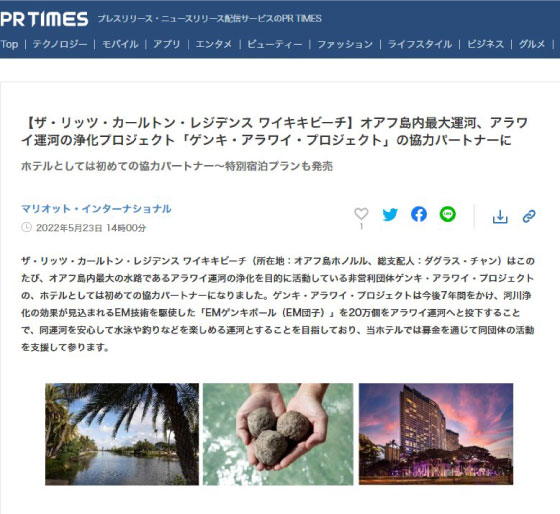
The Hotel became the first hotel to become a partner of the “Genki Ala Wai Project,” a project to bioremediate the Ala Wai Canal, the largest canal on Oahu.
– Special room rates are now available!
Marriott International
2 p.m. May 23, 2022 14:00
The Ritz-Carlton Residences Waikiki Beach (Honolulu, Oahu; Douglas Chan, General Manager) has become the first hotel to partner with the “Genki Ala Wai Project,” a non-profit organization dedicated to cleaning up the Ala Wai Canal, the largest waterway on the island of Oahu. The Genki Ala Wai Project aims to make the Ala Wai Canal safe for swimming and fishing by tossing in some 200,000 EM Genki Balls (EM bokashi mud balls) into the canal over the next seven years. The expectation is that EM technology will help in bioremediation and in revitalizing the canal. The hotel will support the organization’s activities through fundraising.
Source:
https://prtimes.jp/main/html/rd/p/000001029.000011305.html
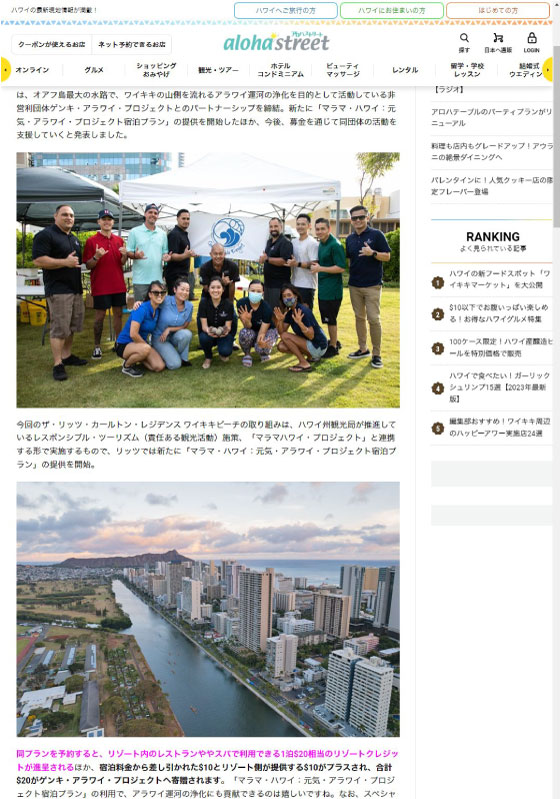
A high-rise hotel condominium in Waikiki, The Ritz-Carlton Residences Waikiki Beach, has partnered with the Genki Ala Wai Project, a non-profit organization working to clean up the Ala Wai Canal, which runs along the mountain side of Waikiki and is the largest waterway on Oahu. In addition to newly offering the Marama Hawaii: Genki Ala Wai Project Accomodation Plan, they announced that they will support the activities of the organization through donations.
This initiative at The Ritz-Carlton Residences Waikiki Beach will be implemented in collaboration with the Marama Hawaii Project, a responsible tourism policy promoted by the Hawaii Tourism Board, and the Ritz has started offering a new Marama Hawaii: Genki Ala Wai Project Accomodation Plan.
If you book this plan, you will receive a resort credit equivalent to $20 per night that can be used at restaurants and spas in the resort, plus $10 deducted from the room rate and $10 provided by the resort, for a total of $20 that will be donated to the Genki Ala Wai Project. We are happy to contribute to the cleanup of the Ala Wai Canal by using the Marama Hawaii: Genki Ala Wai Project Accommodation Plan. This special accommodation plan is valid until Thursday, December 8, 2022.
In order to clean up the Ala Wai Canal the Genki Ala Wai Project uses a special solution called EM-1® (Effective Microorganisms®) to enhance the ability of organisms such as microorganisms and plants to decompose, and accumulate chemical substances, and utilizes EM Genki Balls (EM Bokashi mud balls), which use EM technology (bioremediation technology) to clean contaminated soil and groundwater.
By throwing in EM Genki Balls, which are collection of good bacteria that exist in nature, such as phototrophic bacteria, fermenting type lactic acid bacteria, and yeast, into the canal, the aim is to decompose sludge in the canal, purify the water, increase phytoplankton, and suppress harmful bacteria and odors.
Source:
https://www.aloha-street.com/article/2022/08/374299/
In Okinawa, cherry blossoms start blooming around the middle of January. This year, with the particularly warm weather around the beginning of January, cosmos sunflowers, and flowering trees in parks are bursting with blossoms. Continuing from the last time, we will note information on unusual stray birds and flowers as phenomena seen after the establishment of the EM Gravitron barrier in Okinawa.
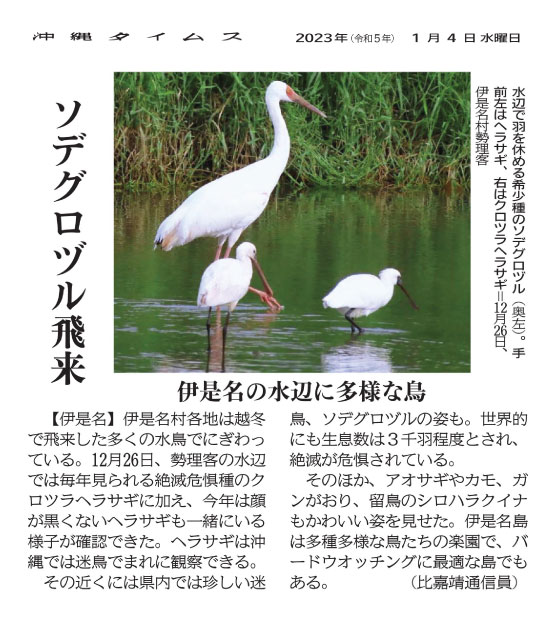
A Siberian white crane (rear left), a rare species, is seen resting by the water’s edge. A Spoonbill is at the front left, while a black-faced spoonbill is on the right. Taken December 26 in Jitchaku, Izena Village.
Okinawa Times, Wednesday, January 4, 2023
A Variety of Birds on the waterside in Izena
Izena Village, Okinawa Prefecture is bustling with waterfowl that have migrated for the winter. In addition to the endangered black faced spoonbills that are seen every year, on December 26th we were able to confirm that a spoonbill with a non-black face was also seen at the waterfront in Jitchaku. Stray spoonbills are rarely observed in Okinawa. Nearby, a Siberian white crane, a rare stray bird in Okinawa Prefecture was also observed. With only about 3,000 of these birds in the world, they are an endangered species. In addition, there were gray herons, ducks, and geese, as well as a cute looking resident white-breasted waterhen. Izena Island is a paradise for a wide variety of birds, making it an ideal island for bird watching.
(Reported by Yasushi Higa)
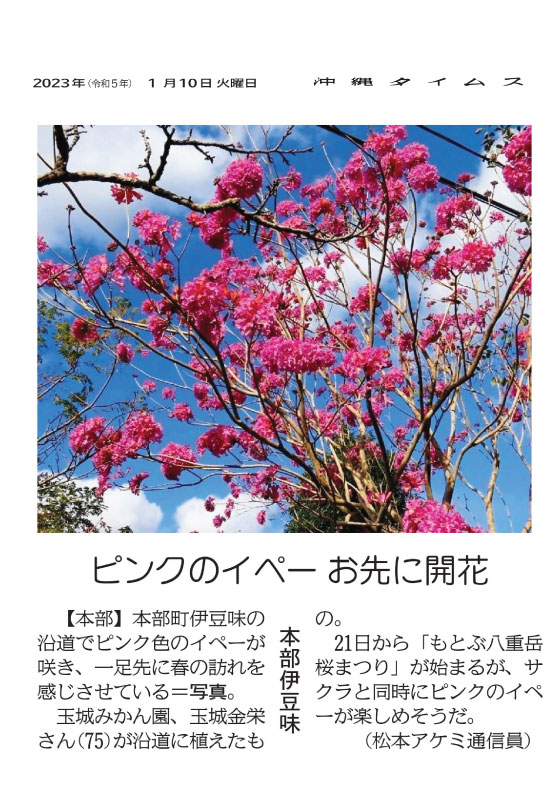
Okinawa Times, Tuesday, January 10, 2023
Pink Ipe is blooming along roadside in Izumi, Motobu Town, a step ahead of other flowers, reminding us that spring has come. (See photo) This Ipe tree was planted along the roadside by Mr. Kinei Tamaki, 75, of Tamaki Mandarin Orange Orchard. The Motobu Yaedake Cherry Blossom Festival will start on the 21st, and visitors can enjoy the pink Ipe along with the cherry blossoms.
(Reported by Akemi Matsumoto)
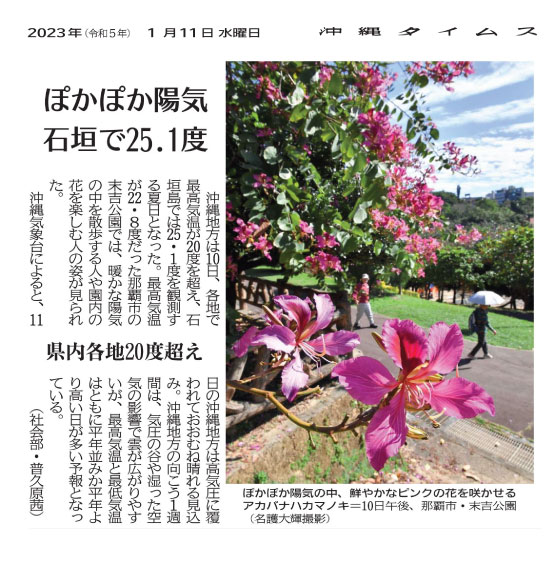
Okinawa Times, Wednesday, January 11, 2023
Temperatures exceeded 20℃ in many parts of the prefecture
On January 10th, the maximum temperature exceeded 20℃ in many areas of Okinawa, and Ishigaki Island recorded a high of 25.1℃, summer-like temperatures. At Sueyoshi Park in Naha City, where the highest temperature was 22.8℃, people were walking in the warm weather and enjoying the flowers in the park. According to the Okinawa Meteorological Observatory, a high pressure area is expected over the Okinawa region on the 11th, with mostly sunny weather. The forecast for the next week in the Okinawa area predicts clouds spreading due to a combination of low pressure and moist air, but both the high and low temperatures are forecast to be at or above average on many days.
(Akane Fukuhara, Social Affairs Dept.)
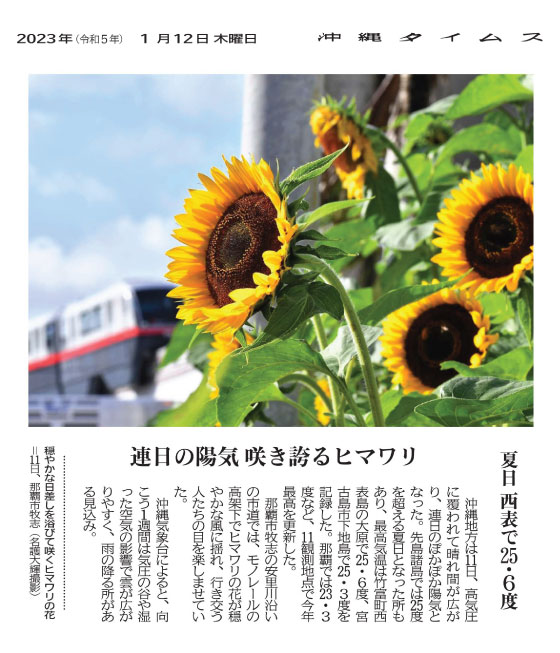
Sunflowers blooming in the mild sunlight--November 11 (photographed by Daiki Nago)
Okinawa Times, Thursday, January 12, 2023
Summer days, with temperatures reaching 25.6 ℃ in Iriomote
A high pressure system covered the Okinawa region on the 11th, making for many warm and sunny days. Some parts of the Sakishima Islands experienced summer-like temperatures exceeding 25℃, with the highest temperatures recorded at Ohara, Iriomote Island, Taketomi Town, reaching 25.6℃, and 25.3℃ at Shimoji Island in Miyakojima City. Naha reached 23.3℃, and eleven other observation sites recorded the highest temperatures of the year.
On the streets along the Asato River in Makishi, Naha City, sunflowers swayed in the gentle breeze under the elevated monorail tracks, delighting the eyes of passersby.
According to the Okinawa Meteorological Observatory, during the next week a pressure trough and moist air will bring clouds over much of the area, and rain is expected in some areas.
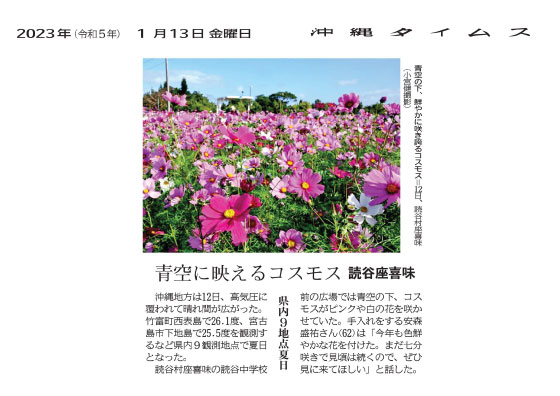
Brightly blooming cosmos under the blue sky, in Zakimi, Yomitan Village on the 12th (Photo by Ken Komiya)
Okinawa Times, Friday, January 13, 2023
Summer-like weather at nine location in Okinawa
On the 12th, the Okinawa region was covered by a high pressure system and skies were sunny. Nine observation sites in the prefecture recorded summer-like temperatures, including 26.1℃ at Iriomote Island in Taketomi Town and 25.5℃ on Shimoji Isaland in Miyakojima City. At the plaza in front of Yomitan Junior High School in Zakimi, Yomitan Village pink and white cosmos flowers bloomed under the sunny skies. Morihiro Yasumori, 62, who takes care of the cosmos flowers, noted that, “The flowers were colorful again this year. They are still only 70% in bloom and the best time to see them continues, so please come and enjoy them.”
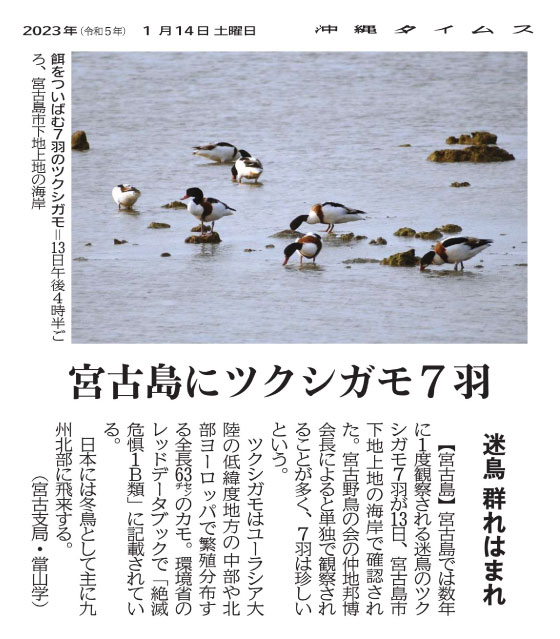
Seven common shelducks pecking at food on the coast of Shimoji Uechi, Miyakojima City, at around 4:30pm on March 13.
Okinawa Times, Saturday, January 14, 2023
Stray migratory birds, with rare flocks
On the 13th, seven common shelducks, stray migratory birds that are observed once every few years on Miyako Island, were sighted on the beach in Shimoji Uechi, Miyakojima City. According to Kunihiro Nakaji, chairman of the Miyako Wild Bird Society, they are often observed alone, and seven birds flocking together is a rare occurence.
The common shelduck is a 63 cm long duck that breeds and lives in low-latitude regions of Eurasia and in central and northern Europe. It is listed in the Ministry of the Environment’s Red data book of an Endangered Species 1B.It is a winter bird in Japan, flying mainly to northern Kyushu.
(Manabu Toyama, Miyako Branch office)
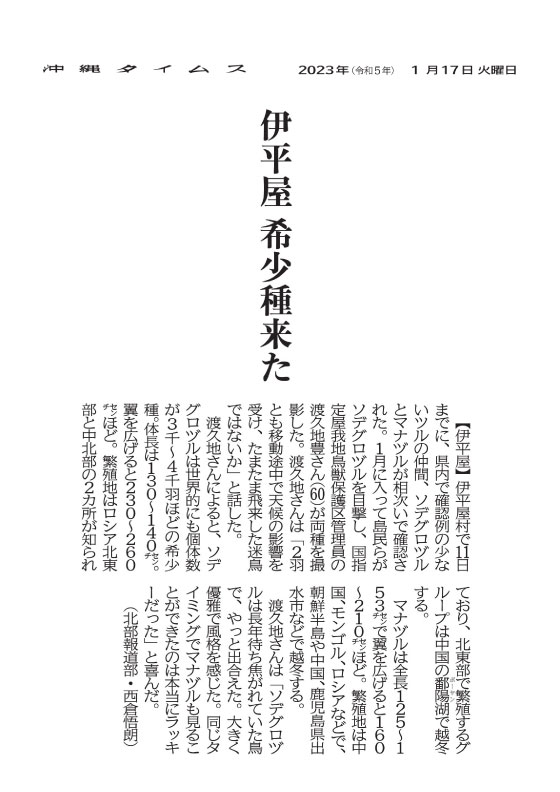
In Iheya village, two species of cranes, the Siberian Crane and the White-naped Crane, which are rarely seen in the prefecture, were confirmed one after another by the 11th. In January, residents spotted a Siberian Crane, and Mr. Yutaka Toguchi, 60, a manager of the nationally designated Yagaji Wildlife Sanctuary, photographed both species.
Mr. Toguji noted that, “Both birds were probably stray migratory birds that happened to fly in due to weather they encountered during their migration.”
According to Mr. Toguchi, the Siberian Crane is a rare species with a global population of only about 3,000 to 4,000 birds. Their body length is 130 to 140 centimeters, with a wingspan of 230 to 260 centimeters. There are two known breeding grounds in northeastern and north-central Russia, with a northeastern breeding group overwintering in Poyang Lake in China.
The White-naped crane is 125 to 153 centimeters long with a wingspan of 160 to 210 centimeters. They breed in China, Mongolia, Russia, etc., and winter on the Korean Peninsula, in China, and in Izumi City, Kagoshima Prefecture.
“I was finally able to observe a Siberian crane, which I had been waiting so long to see,” Mr. Toguchi said happily. “It was very large and graceful, and sort of classy looking. I was very lucky to see the white-naped crane at the same time.”
(Goro Nishikura, Northern Press Department)
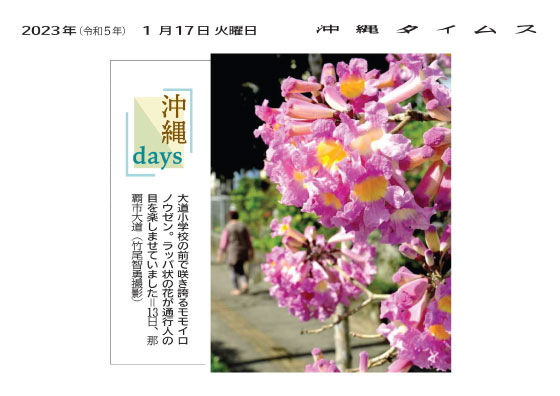
Okinawa Times, Tuesday, January 17, 2023
Pink trumpet tree in full bloom in front of Daido Elementary School.
Passersby found the trumpet-shaped flowers pleasing to look at. January 13th in Daido, Naha City (Photographed by Mr. Takeo)
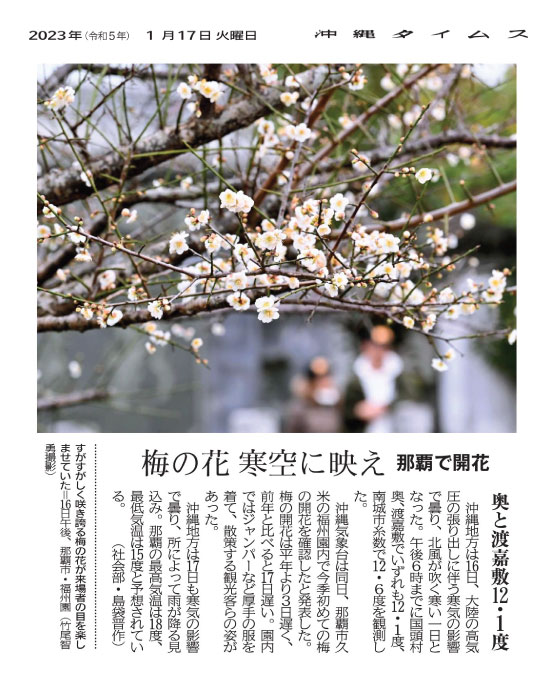
The freshly blooming plum blossoms delighted visitors to Fukushuen Garden in Naha City on the afternoon of March 16th. (Photo by Mr. Takeo)
Okinawa Times, Tuesday, January 17, 2023
12.1 degree Celsius in Oku and Takashiki
On the 16th, cold air from by an overhanging high-pressure system on the continent caused the Okinawa region to be cloudy, with a cold north wind blowing. By 6 p.m. the temperatures in both Oku and Tokashiki in Kunigami Village stood at 12.1℃, with the temperature at 12.6℃ in Itokazu, Nanjo City.
On the same day, the Okinawa Meteorological Observatory announced that it had confirmed the first Ume plum blossoms of the season in Fukushu Garden in Kume, Naha City. This year the ume plum trees bloomed three days later than normal and 17 days later than the previous year, and with the cold weather tourists were seen strolling in the park wearing warm, heavy jackets.
The Okinawa region will continue to be cloudy on the 17th due to the cold weather, and rain is expected in some places. The predicted high temperature in Naha is 18℃,with the low expected to be 15℃.
(Shinsaku Shimabukuro, Social Affairs Department)
Read the original Japanese message at the link below.
2023.4.1 Updated.